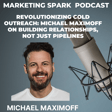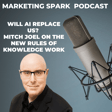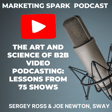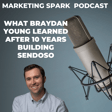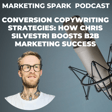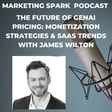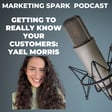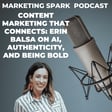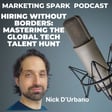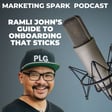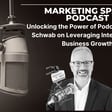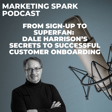Become a Creator today!Start creating today - Share your story with the world!
Start for free
00:00:00
00:00:01

How to Build a Content Marketing Creation & Promotion Machine
Building a content marketing strategy is a lot like building a house, says Visme's Farzad Rashidi .
You need a good foundation and infrastructure and a nice facade.
You need to have a clear understanding of the best keywords that will attract readers to content and determine the most relevant channels to publish content.
But creation should only account for 20% of your time.
80% should be devoted to promotion and distribution, as well as updating and refreshing existing content.
That's the formula for content marketing success.
Transcript
Content Marketing's Vital Role in B2B SaaS
00:00:05
Speaker
Hi, it's Mark Evans, and you're listening to Marketing Spark. Content marketing is hot, red hot. For B2B SaaS companies, content is how they've attracted and engaged customers over the past 19 months. And even with conferences slowly reemerging, the strategic importance of content marketing will continue. But here's the thing, content for the sake of content is a waste of resources, time, and money.
00:00:35
Speaker
Like any type of marketing, content needs to make a financial impact by turning prospects into customers.
Visme's Content Strategy Success Story
00:00:42
Speaker
Farzad Rashidi has seen the power of content marketing firsthand at Visme, which became a highly profitable rival to Canva and Vengage and generated organic traffic of more than 2 million visitors per month. Welcome to Marketing Spark, Farzad. Glad to be here. Thank you very much for the invite.
Evolution and Challenges in Content Marketing
00:01:02
Speaker
Before we get into the content marketing magic that happened at Visme, I'm interested in your take on the content marketing landscape. How have you seen it evolve over the last 19 months? What are some of the things that have surprised you the most?
00:01:18
Speaker
So one thing that's quite clear is that there is a lot of noise. And unfortunately, a lot of companies have started to do content. And they sort of have a checkbox of having a blog on their site. And they purchase a few pieces of content, put it on the site, and call it a day. And they get zero traffic from it. So normally,
Creating Balanced and Effective Content
00:01:39
Speaker
they just never think about it.
00:01:40
Speaker
Lots of other companies that are pursuing content seriously, it's more so becoming a matter of SEO traffic. So they basically are overdoing the scientific portion of writing content, which is doing keyword research, keyword stuffing, and they normally don't care as much about the content piece that's actually being published or that adds value.
00:02:07
Speaker
And so the happy medium where basically you're still researching your audience, understanding what they're looking for, and writing actual, you know, valuable, actionable pieces of content where your potential customers and audience could put in use is done quite rarely. But people have started to figure this out, that the only way to really make this work, they actually have to start investing in content.
00:02:34
Speaker
That's sort of been something that has been happening over the course of the past 10 or so years. But nowadays, what's happening is people's attention spans are sort of shortening. And a lot of it has to do with the fact that there's just so much going on nowadays, especially with social media.
00:02:54
Speaker
that it's hard to grab an audience's intention for long periods of time. So what businesses started doing is to start creating content through a variety of different channels, could be video and take an omni-channel approach, where I see definitely things are heading towards. But as far as content itself goes, I think that tech, the good old tech space content, not going anywhere. It's just that to do it right and
00:03:22
Speaker
put all the pieces of the puzzle together is still quite time consuming and resource intensive. The companies who actually do invest in it are at a competitive advantage compared to their rivals who aren't. So let me ask you the $64,000 question. It's relatively easy to create content. As an ex-journalist and a content marketer, I know that you can put a bunch of writers in a room and they can create content. But as you say,
00:03:50
Speaker
It's a noisy landscape right now. There is so much content being published and more companies have jumped on the bandwagon in the past 18 months. How do you create high quality content or valuable content that actually resonates and makes an impact, content that breaks through? I'm asking you a loaded question, but as someone who has been in the midst of this content marketing landscape and helped the company stand out from the crowd, what are your thoughts about this?
00:04:20
Speaker
I'm glad you asked. So the answer to that question is quite a few hours long.
Building a Strong Content Strategy Foundation
00:04:26
Speaker
Let's get into a few minutes. We're going to summarize a little. The way I paint content marketing is always as a house. Building a content strategy is a lot like building a house. You need to have a good foundation and a good infrastructure and a nice facade.
00:04:46
Speaker
So step one in any content marketing strategy is the right site structure so that normally requires attention of a person who's somewhat SEO savvy again none of these is rocket science but you need to understand okay what are some of the key keywords that we are operating it so say for Visme as an example.
00:05:07
Speaker
There's multiple use cases for our platform, presentations, infographics, and say, social graphics. These are our parent keywords per se. So these are the ones that we ideally want to build our site around. Within that site, we want what we call a landing page or a sales page. So for example, as a consumer,
00:05:27
Speaker
When I need to create a presentation tomorrow, what I need to do is to go look up, what do you do, Mark, when you're looking for a solution in any space? What's the first step you do intrinsically? Do a search. There you go. Right. Where do you do a search?
00:05:42
Speaker
Google right exactly exactly so presentation software infographic maker right the reports maker etc so these are what we call our landing pages sales pages in order to make these landing or these these sales pages competitive what we did what we do is to create what we call topical authority so we create these categories or silos as
00:06:06
Speaker
you know, fancy marketers call it, of content. Meaning, basically, it's just a simple way of saying just create content about presentations. So for our presentation landing page, we create how to make a presentation. What are some of the best ways to present in front of an audience, right, etc.
00:06:25
Speaker
And each one of them have an internal link structure, so they cross-reference each other, so that the site is well woven together. So that's step one, building a right site structure.
00:06:38
Speaker
Step two is to start identifying what are some of the phrases or keywords that your audience are searching for, but that's not enough. You need to prioritize it because there's going to be a gazillion of them in any sort of space that you want to touch on, anything from manufacturing to beauty.
00:06:58
Speaker
What's going to happen is they're going to end up with a million keywords. Now, in order to prioritize what are some of the keywords they want to go after, you need to start what I call, I made this little simple formula, what I call the opportunity keywords, where we're trying to prioritize these phrases where they get a lot of hits. So they're actually, people are actually curious and they're actively searching for. So they get high volume and clicks and
00:07:26
Speaker
You got to make sure they actually have some commercial intent. So it's not just googling about stuff, but they actually are looking to take action and purchase something, whether it's a product or service. And at the same time, want to make sure that these keywords are not dominated by the big guys in the industry. So the competitiveness is somewhat relatively lower. So that sweet spot, that middle ground is what we call the opportunity keywords.
00:07:50
Speaker
we make this little formula for folks can Google it, just look up this me marketing strategy. And I wrote a little ebook that go through all this for that sort of step by step. So folks can download that ebook and kind of follow through is free. But anyhow, as far as the content strategy goes, once we have our or keywords that we know what we
00:08:13
Speaker
trying to create. Then you want to segment it, okay, is this better suited for a YouTube video? Is this a better blog post? Is this another landing page? Is this a template page?
The Power of Content Promotion
00:08:22
Speaker
And you create these pages on your website, and that's what I call a right infrastructure or a base for your website.
00:08:32
Speaker
Now you gotta build a facade up or build the walls and the plumbing, the electricity to go up. In order to show that, hey, this is a house, it's not just a foundation, right? So a lot of people just stop there. I would say 90% of people I know. It's just basically just put out a piece of content, create a bunch of landing pages, and they just think that people are magic to kind of show up at their door and people are gonna just form lines and try to knock down the doors of the website to come in.
00:08:59
Speaker
And that's rarely the case, right? Unless you're Apple, where, you know, when you release a new iPhone, you get a spike on your track.
00:09:07
Speaker
So most of us are an Apple or Google or these Fortune 100 companies. So what do we do? Well, that's where content promotion kind of kicks in. So we actually spent 20% of our resources on content creation, and that includes building landing pages, development, creating content. 80% of our resources go into content promotion. And it sounds quite scary because a lot of businesses are like, hey, we don't have all these resources to go start promoting pieces of content.
00:09:37
Speaker
And to answer that, I said, just don't produce as much content then. It's a matter of dedication and resources. When you put out a thousand blog posts on your website and nobody looks at it and it doesn't rank for anything, that's a waste of money. Produce one blog post, one very good blog post every month and spend the rest of the month promoting that piece of content.
00:09:57
Speaker
Well, the obvious question is, in theory, it sounds great. But in terms of practical terms, how would you take a blog post? Let's say it's a 750 to 1000 word blog post, good content, helpful content. What do you do with it? Walk me through how you would extract as much value from that one piece of content.
00:10:20
Speaker
So a lot of people think of content promotion as just going out and putting it on their social media and gets like two likes. And they're like, yes, they made it. And then they put it in their newsletters, send it to their own existing customers.
00:10:37
Speaker
That to me is not content promotion. Yes, you got to do that because you have to. But it's not even in our strategy. It's just something that naturally happens. Content promotion to us comes back to the main purpose of the content piece. So once you create a piece of content, you want to use this as a magnet to bring in potential customers.
00:10:59
Speaker
position yourself to show up in places where people who are looking for a solution or service like you would naturally and organically find you. Most of that traffic happens on Google. So how do you get that content piece ranked for that target keyword?
00:11:15
Speaker
And in order to do that, you need to understand how some of the search engines work. And I always come up with this example of a Mean Girls popularity con. The way this search engine works is that the more other authoritative, relevant websites in your space are talking about you and actually obviously mentioning a link to your website. That's a vote of popularity in nice Google and other search engines.
00:11:38
Speaker
It just tells them that, hey, this must be a credible source because other people are linking to it. Just like how universities research papers are valued based on the amount of citations they have. But not all citations are created equal. So you want to make sure that the people we're actually talking about you are authoritative.
00:11:57
Speaker
Now, in order to do that, people just don't actually come and find you again. It's not a spray and pray approach. It is somewhat of an active process of promotion. So that's sort of what was also the original story of how Respondent came into play. So back in the day, what we were doing, anytime we would put out a piece of content,
00:12:15
Speaker
would have to actually go and use these Google Advanced Operators and try to do some research, try to identify what are some of the content pieces that other people have created that have mentioned or talked about very briefly about the content piece. For example, let me give you an example so it makes sense. Say I put together a guide on lead generation, ultimate guide to lead generation. And I'm a lead generation agency. And I want to get that guide up in the search results. Now, it's a very competitive
00:12:45
Speaker
content. Now, ideally, what I want to do is to find other content pieces that are mentioning what are some of the top marketing strategies for B2B SaaS companies, right?
00:12:56
Speaker
And as part of their content, they happen to mention lead generation as one of the strategies. But obviously, the focus of the content is something else, so they don't get to dive deep into the topic. So I want to ideally identify first these non-competing posts that happen to mention our keyword in there and reach out to them and incentivize them to mention us. Now, that's a whole slew of different tactics and strategies. I want to keep it to the broad.
00:13:25
Speaker
And also, another thing you want to do is to reverse engineer what's already working. So we want to go take a look at all the other guys lead generation into top 10 search results in Google and see what are some of the resources or other posts and blog articles. I have mentioned them.
00:13:40
Speaker
and extract the list and reach out to them, especially if you have a superior post and it's what we call it, a reverse skyscraper ticket. But identify these opportunities that you could reach out to and that whole process and then it leads you to start finding the right people.
00:13:57
Speaker
and understanding, okay, for this site, for this page, who would be the best person that I could reach out to? What would be the right pitch? That collaboration also, you know, leads to a guest post and then leads to a longer term partnership. And that's sort of the whole process of prospecting, identification, finding contacts and outreach, something that we were sort of piecing together a business manually, duct taping a bunch of different tools and
00:14:24
Speaker
had a bunch of data miners and manual work. And it was quite tedious, as you might imagine. That sort of sparked the idea of Respondent.
The Birth of Responder from Visme's Needs
00:14:35
Speaker
So we were like, all right, well, we are a software company. Why don't we just put together the whole process that's already working for us manually, put it in a software so we can scale without losing quality. So let me stop you there, because you've talked about Respondent. But maybe tell the story of Respondent, because it's a spin-off.
00:14:52
Speaker
something that emerged from within this me you have this problem that you're talking about in terms of content promotion. It's a classic we've got a problem let's build a tool to fix it what is responded how does it work and is it just available to this me or is it going to be available to other content marketers.
00:15:12
Speaker
So Raspana, there's no D in there, by the way. You got it. We built this initially as an internal software. So we were basically like, hey guys, this content promotion process is long, it's tedious. Let's put together a really ugly UI and duct tape these steps together so we can sort of have just one screen so that one person can sit down and go from A to Z in a few minutes instead of
00:15:42
Speaker
spending hours doing research and hopping different tools. So that was initially built as an MVP as an internal software. And what happened was that it just worked very well. We sort of 10x our productivity or more. And also we cut around 80% of average cost because we let go of six full time staff members whose job was just data mining.
00:16:06
Speaker
canceled a bunch of paid subscriptions that we had. And we were like, all right, guys, I think we got something here. And up to this day, Visme is still Responders biggest customer, but what we decided to release Responders as a standalone product, start a separate company and sort of have that.
00:16:22
Speaker
runs course and over the course of the past couple of years have been mainly catering to other SaaS companies that are doing the same thing and also a number of really high level SEO agencies and people that are doing these sort of tactics for their clients.
00:16:40
Speaker
And other publishers, people who have a publishing website or to have some sort of affiliate website. So that sort of led to the creation of Respana now. I sort of shifted away from Visme and sort of running the operation here at Respana. We've got a separate team here now. But yes, that initially was sort of incubated out of Visme.
00:17:05
Speaker
So I'm curious about the separation between the two companies. So are they different entities? And what are some of the management challenges when you've got this love child, for lack of a better word, that has emerged from the parent is now standing on its two feet and it could become high growth company. Are they split in half? Are they still interweaved? How have you structured this new entity?
00:17:32
Speaker
We were very adamant on keeping both products separate. The reason why is that VisMe, in and out of itself, is a very successful company. For folks who don't know what it is, it basically is a brand management or brand content creation platform. Mark, you create all sorts of social media assets and you create presentations and
00:17:52
Speaker
especially in large organizations where they have to keep everybody on the same page in terms of brand guidelines and logos and colors and fonts. So this means sort of all in one hub that allows businesses to be able to create these sort of content pieces without lacking or impacting quality.
00:18:09
Speaker
It's a pretty interesting product. Our founder, Viz means founder, Paimon, who is a co-founder at Respawn, actually, launched this back in 2013. Now it's got over, I think we've passed just 12 million active users. And over 80 employees, fully profitable, growing at a very healthy rate.
00:18:31
Speaker
And so that whole operation is what payment is managing. So Respana was sort of, since it was initiated by me and created by me, and it was sort of, so the responsibility for the management on the Respana side fell on
Regular Content Audits for Continuous Improvement
00:18:46
Speaker
me. So we hired a separate engineering team, we have a separate marketing team, so we try to keep things separate so that, and not one is impacting the other by eating up resources.
00:18:59
Speaker
Maybe you went back to the content marketing production world. What are your thoughts about how to maintain the production of high quality content? Because it's easy to get excited in the short term and to create a number of great blog posts or eBooks or infographics.
00:19:18
Speaker
But in time that enthusiasm can wane the ideas aren't as there's not as many they're not as they don't flow as as well or as fast as they used to so when you look at this me and the way that it approaches content how do you keep the engine rumbling forward to that you're constantly creating great content month after month year after year.
00:19:39
Speaker
Content production, once the content is out in the world, doesn't mean your job's done. So every six months, we actually run a content audit and go back to post that are six months or older and see what posts are underperforming. And that includes time on site, whether it's lost in rankings, whether it has any backlinks or getting any sort of traffic.
00:20:02
Speaker
We actually delete posts that don't have any links or get any traffic after six months. It's just a waste of space. There are posts that have a good number of backlinks mentioned, but the rankings have started to drop. Let's go ahead and update and refresh that post. It's a constant dynamic process of evaluating content pieces that have been created in the past and keeping the plot going.
00:20:27
Speaker
So that's number one is that you don't want to just put out a piece of content let us sit there for ten years right at some point gonna hit zero side from content refreshes another thing we do is that we don't have just two people at the company whose job is to write.
00:20:43
Speaker
because sooner or later, they're gonna run out of topics to write about, or what's gonna happen is that, because it's almost impossible that a person is a jackal trait, so they start writing that stuff that's not necessarily relevant to them. For example, it's like if I had to run a cooking website, I'd be horrible, because I can barely scramble X to get it, right? So I can't write about topics I'm not, so what we do at this, maybe we have a,
00:21:09
Speaker
pretty good network writers that we've tried and tested over years. And each one is an expert in something. So like one person is good with writing content pieces about design because they have a design background, right? So there's a million pieces that can write about design. And we have another person that who's
00:21:26
Speaker
expertise in digital marketing, right? They come from the marketing world and no one is in and out. So having a network of writers, they can bounce ideas off of and not just necessarily have two people in charge of writing content per se. That helps a lot with keeping things creative. So to be clear, do you have in-house writers as well, as well as a network of writers? So you're tapping both internal and external resources to create content.
00:21:53
Speaker
Yes, but the in-house folks are predominantly in charge of quality control. So they basically are delegating tasks, reviewing content, editing, publishing, and also doing the research part at the top of the funnel, right? So, okay, understanding what do we need to write about? What do we need? What are we underperforming? Do we have a new feature coming out? Okay, let's see what silo we need to target. Their job is mainly predominantly to put together this content brief that they get passed on to the writer who's now is going to sit up right from
00:22:24
Speaker
What are some of the mistakes that B2B SaaS companies make when it comes to content marketing? I know you're going to talk about promotion, you're going to talk about how to create quality content, but what do you see as the top two or three mistakes that many companies make when it comes to content?
00:22:39
Speaker
Number one, content marketing is not for everyone. A lot of companies feel the obligation to have a blog, feel the obligation to start producing content just for good measure and no clear strategy in mind. I always advise. Sometimes some businesses, it just doesn't make any sense. If you're a super enterprise software that sells 100k plus a year licenses,
00:23:02
Speaker
it may not make sense to start writing content about it. Because guess what? Your target customers aren't googling for 100k plus license to the software. Normally that requires a different sales cycle. It requires some outbound, requires some salespeople and SDRs and etc. Or events, venues, you name it. It's not always done through Google. So first understanding, okay, where are my audience hanging out?
00:23:27
Speaker
And that's something that's a question that a lot of businesses don't even consider. They just start writing content or just higher writing. So that's number one, mistake number one. First, I understand if it's the right fit for you. That leads me to number two, and that's dedicating enough resources to it.
ROI of Strategic Content Marketing
00:23:44
Speaker
So a lot of businesses, they do not like, okay, think about it. I would assure you, 90% of businesses who are actually listening to this,
00:23:53
Speaker
spend most of their money into paying salaries of SDRs or paid advertising. Those two channels normally occupy the majority of the marketing budget.
00:24:05
Speaker
very little startups invest as heavily in content as companies like Vezme or Responded do. And the reason being is it's a silent channel that has a very large lag. So you can just put some ads and once you start doing Google ads, you can see results. You can say, okay, here's how many impressions we got. This is how many conversions. This is clear cut. This is great. Let's keep on doing this. It's a never ending black hole of cash.
00:24:31
Speaker
Content is something that you're just sort of producing educational resources, putting out in the world, no idea who's going to see it. Okay, you get some traffic, are you actually converting to customers? Because it's not as clear, people don't invest as much in it. So once you identified, okay, this is a channel that people are actively looking for our services online, and mainly through Google, now I'm producing business content, don't
00:24:56
Speaker
I'm sorry, excuse my French, don't half-ass it, roll in. You want to make sure you're putting the pieces right because it's a waste of money otherwise, if you're going to skip any of these steps. Dedicating enough resources, and personally, I don't know any other marketing channel has had this amount of ROI that Content and SEO has had for us.
00:25:17
Speaker
This means traffic. You know how much money we would have to spend in advertising and in AdWords in particular based on the keywords that we're ranking to bring in this level of traffic and signups using AdWords? Pick a number. Million dollars. It's about 1.4 million dollars a month. Wow. That is huge. That's a huge number.
00:25:38
Speaker
Every month, we would have to spend 1.4 million to bring in this amount of signups and traffic. When you think about the amount of money we spend in content, that's a pretty damn good ROI. Now, granted, it took us a few years to get here. It didn't happen overnight. But when you actually put them head to head, OK, do we need to spend every $1.4 million a month, every month, forever, versus planting these seeds and putting together these pieces of content. Now, over time, they're going to actually start yielding results.
00:26:06
Speaker
given that your audience are looking for solutions like you on Google, then that's a no-brainer to me.
00:26:13
Speaker
One final question, and this is a loaded question, but it's being talked about a lot these days, is the where you fall when it comes to gated versus ungated content. A lot of B2B SaaS marketers want to gate content because it generates email addresses. A growing number of marketers are saying that content should be free. What's your view of the world when it comes to gated content or ungated content?
Strategic Use of Gated vs. Ungated Content
00:26:39
Speaker
I don't think they're mutually exclusive. I'm not against either one. I think you should do both if you have the resources for it. It's just a different type of content. If it's an educational resource that people are actively searching for, then great. Let's go ahead and put this as a blog post. There's no reason for it to be gated. Now, if you've done some original research, run some surveys, and got some data, and you got something interesting that people who are in your space would
00:27:03
Speaker
be willing to put in their information and take a look. And it's not really a type of content that you would put on a Google and people would be actively searching for.
00:27:11
Speaker
Then yeah, that's much better suited for a gated piece of content. Now the way you acquire impressions is different. You've got to be spending some ads on LinkedIn with these like forums that people can automatically pre-fill and opt into your list and get access to that ebook, or you already have an existing newsletter base or audience that you can promote this to. Not a cool thing we've done also with gated content is that we partner up with another company.
00:27:37
Speaker
So we partner out with Mark, you, and we say, okay, Mark, you go ahead and take care of this research part. And we flesh it out and we take care of the design and the writing out the content and sort of putting it together. Let's put our money together and let's both promote it to each other's audience and split an ad budget.
00:27:58
Speaker
in both ways. Let's share the leads that we get from both of these, or from these ebooks, right? So you sort of double out the ROIs. It's also something that we do on an ongoing basis with other businesses as well.
Connect with Farzad Rashidi and Explore More
00:28:14
Speaker
Well, Farzad, this has been an excellent and inspiring conversation. Where can people learn more about you, Visme, and Respana?
00:28:22
Speaker
You can connect with me on LinkedIn. There's not a whole lot of people named Farza Dorshidi, so I'm pretty into the spot on social media. LinkedIn is my main channel. You can connect with me there, and also Respana.com, Visme.com, and that's where they can learn about our business.
00:28:39
Speaker
Thanks for listening to another episode of Marketing Spark. If you enjoyed the conversation, leave a review, subscribe via Apple Podcasts, Spotify, or your favorite podcast app, and share via social media. To learn more how I help P2B SaaS companies as a fractional CMO, strategic advisor and coach, send an email to mark at marketingspark.co or connect with me on LinkedIn. I'll talk to you next time.

